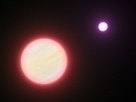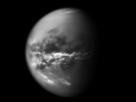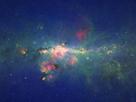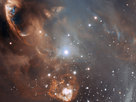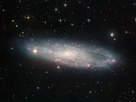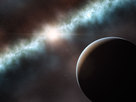Curious features
A Disturbed Galactic Duo
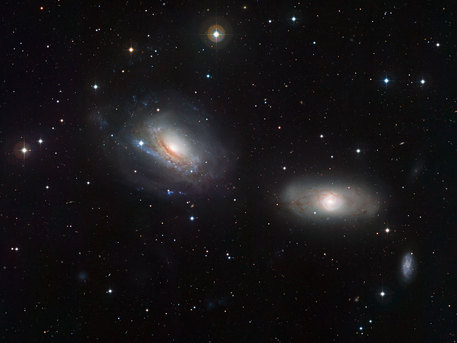 © ESO |
Spiral galaxies NGC 3169 and NGC 3166
Spiral galaxies like NGC 3169 and NGC 3166 tend to have orderly swirls of stars and dust pinwheeling about their glowing centres. Close encounters with other massive objects can jumble this classic configuration, often serving as a disfiguring prelude to the merging of galaxies into one larger galaxy. So far, the interactions of NGC 3169 and NGC 3166 have just lent a bit of character. NGC 3169’s arms, shining bright with big, young, blue stars, have been teased apart, and lots of luminous gas has been drawn out from its disc. In NGC 3166’s case, the dust lanes that also usually outline spiral arms are in disarray. Unlike its bluer counterpart, NGC 3166 is not forming many new stars.
NGC 3169 has another distinction: the faint yellow dot beaming through a veil of dark dust just to the left of and close to the galaxy’s centre [1]. This flash is the leftover of a supernova detected in 2003 and known accordingly as SN 2003cg. A supernova of this variety, classified as a Type Ia, is thought to occur when a dense, hot star called a white dwarf — a remnant of medium-sized stars like our Sun — gravitationally sucks gas away from a nearby companion star. This added fuel eventually causes the whole star to explode in a runaway fusion reaction.
The new image presented here of a remarkable galactic dynamic duo is based on data selected by Igor Chekalin for ESO’s Hidden Treasures 2010 astrophotography competition. Chekalin won the first overall prize and this image received the second highest ranking of the nearly 100 contest entries [2].
Notes
[1] Other much more noticeable points of light, such as the one toward the left end of the spiral arm running underneath of NGC 3169’s core, are stars within the Milky Way that happen to fall by chance very close to the line of sight between our telescopes and the galaxies.
[2] ESO’s Hidden Treasures 2010 competition gave amateur astronomers the opportunity to search through ESO’s vast archives of astronomical data, hoping to find a well-hidden gem that needed polishing by the entrants.
Source: ESO
Curious features
A Disturbed Galactic Duo
 © ESO |
Spiral galaxies NGC 3169 and NGC 3166
Spiral galaxies like NGC 3169 and NGC 3166 tend to have orderly swirls of stars and dust pinwheeling about their glowing centres. Close encounters with other massive objects can jumble this classic configuration, often serving as a disfiguring prelude to the merging of galaxies into one larger galaxy. So far, the interactions of NGC 3169 and NGC 3166 have just lent a bit of character. NGC 3169’s arms, shining bright with big, young, blue stars, have been teased apart, and lots of luminous gas has been drawn out from its disc. In NGC 3166’s case, the dust lanes that also usually outline spiral arms are in disarray. Unlike its bluer counterpart, NGC 3166 is not forming many new stars.
NGC 3169 has another distinction: the faint yellow dot beaming through a veil of dark dust just to the left of and close to the galaxy’s centre [1]. This flash is the leftover of a supernova detected in 2003 and known accordingly as SN 2003cg. A supernova of this variety, classified as a Type Ia, is thought to occur when a dense, hot star called a white dwarf — a remnant of medium-sized stars like our Sun — gravitationally sucks gas away from a nearby companion star. This added fuel eventually causes the whole star to explode in a runaway fusion reaction.
The new image presented here of a remarkable galactic dynamic duo is based on data selected by Igor Chekalin for ESO’s Hidden Treasures 2010 astrophotography competition. Chekalin won the first overall prize and this image received the second highest ranking of the nearly 100 contest entries [2].
Notes
[1] Other much more noticeable points of light, such as the one toward the left end of the spiral arm running underneath of NGC 3169’s core, are stars within the Milky Way that happen to fall by chance very close to the line of sight between our telescopes and the galaxies.
[2] ESO’s Hidden Treasures 2010 competition gave amateur astronomers the opportunity to search through ESO’s vast archives of astronomical data, hoping to find a well-hidden gem that needed polishing by the entrants.
Source: ESO





